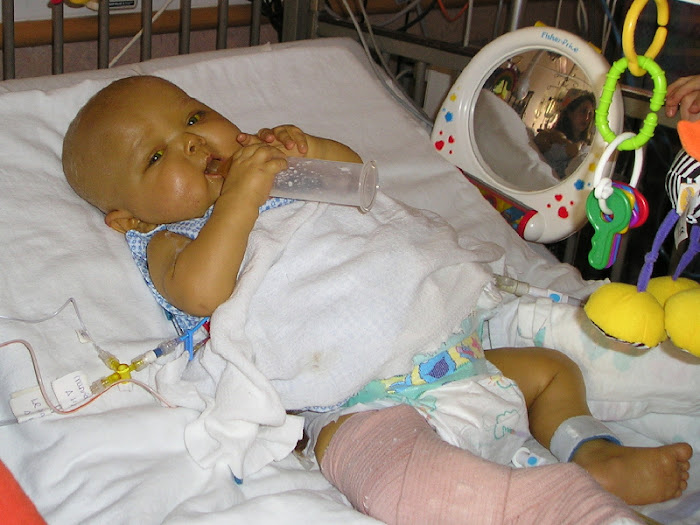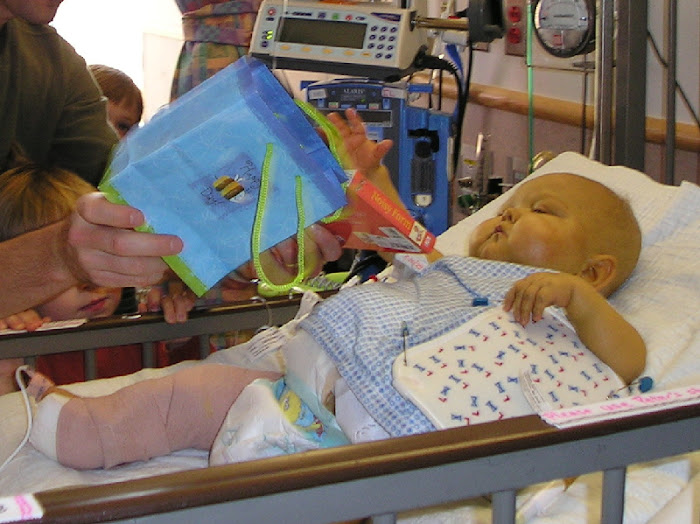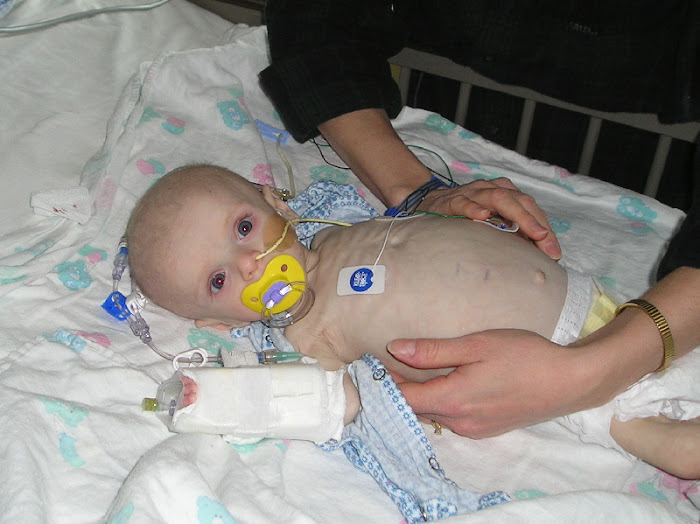Back home again after a "routine check-up" in Boston. We are looking forward to spacing the trips further apart, but not sure when that will happen. We had been going there every two months for visits, but last year went there nine times. It is only March and we've been there twice this year already, with plans to return next month as well for another check-up.
Peter has been doing well with a diet of real food during the day and unflavored formula overnight. He has not gained enough weight or muscle mass to come off a night of TPN yet though. He is down to 400 ml seven nights a week, which is down from the 750 ml that he had been put on after our last trip to Boston.
While we were in Boston, we had some spare time before his appointment so we went to Trader Joe's and found a few fun things for Peter that were low in sodium. (Thanks for your suggestion to look there, Colleen!) They make a very flavorful tortilla chip that Peter fell in love with, called Veggie and Flaxseed Tortilla Chips. He has eaten half a 12 ounce bag in two days! He really craves flavor and there are three distinctly different chip flavors in the bag. They have a long list of low-sodium products that they carry, which will be fun to explore. Unfortunately, many of Trader Joe's products state that they may contain peanuts or be processed in a facility that uses nuts/peanuts, so we need to avoid them until we talk with an allergist about whether Peter can have nuts/peanuts, since he has a brother with peanut allergy. But the chips were a great find. We picked up some Falafel Chips to try as well, no peanut/tree nut warnings there either. The plan between this visit and the next is to keep advancing nighttime feeds and try to get some more fat in during the day. Dr. Kamin told us about whole milk Greek yogurt. We have been using Chobani, which has lots of protein and Peter loves, but the highest fat yogurt they make is 2%, and usually we can only find 0%. He only eats the plain flavor because, like the formula, when sugar is added the osmolality goes up and so can the ostomy output. Even without an ostomy, people with short bowel syndrome often need to watch their sugars to keep stooling down. We found some whole milk Greek yogurt yesterday, with fat content of 15%! It looks like sour cream and is very rich. Peter felt full faster, but we'll keep working with it to see if that might add some more calories. He doesn't like to eat butter, but we are going to try to sneak that into his Gerber purees. He always adds spices to them anyway, so it should be easy to get the butter in without his detection. If we get a "clear" for trying peanut butter, that might give some healthy fat too. He does drink whole-milk Lactaid. (Yes, he eats yogurt, but the team in Boston had awhile ago recommended Lactaid instead of milk, so we've still got him on that so we don't have to re-examine whether it is milk causing a problem with motility.) He does not like avocados and gets tired of eggs after just a bite or two, but they would be good options for quality fat too. Well, enough about food.
Of interest, images of Peter's liver circulation over the last several months seem to show that his portal vein clot is no longer there and that there is some blood flow through the portal vein. Dr. Kamin indicated that this would be expected after time, but that if we looked right up on the portal vein, it would still appear different from a normal portal vein, perhaps scarred and with some reduced flow. I did not realize that the vein would reopen, just thought collateral veins would develop in the belly to overcome the loss of portal vein flow. Peter still has medusa-like veins on his belly, prominent and tortuous, but the hope has always been that with time and growth he would outgrow some of the portal hypertension. There is likely a liver componenent to the portal hypertension as well, so that makes understanding the cause and detemining a solution difficult. There has been discussion many times as to whether a shunt would help reduce the portal hypertension, redirecting the blood flow so that there is just less pressure. The overriding thoughts of all doctors involved is that a shunt would not be good in Peter's case, as it could end up reducing necessary blood flow to the liver. To hear that the portal vein does appear to have flow makes me even more optimistic that the portal pressure will continue to resolve over time, as we have all hoped.
Saturday, March 17, 2012
Sunday, March 4, 2012
Lowering the salt and raising the formula.
Peter has done well with the resumed nighttime feed,s and so far has tolerated 20ml/hr, 25ml/hr, and is now at 30ml/hr. We will be talking with the Boston team in another day about taking off one night of TPN.
The sodium issue has been a bit consuming. There is sodium in almost everything, as I said in the last post. Foods that don't seem salty have surprisingly much salt in them. We have found that almost every dry cereal has quite a bit. There is a good cereal that has only 80 mg sodium though: Heart to Heart oat cereal in warm cinnamon flavor. We have come across a few other good products lower in sodium. I am settling for 100mg sodium per serving at the most, but less is much better, as his servings have been getting bigger as he is getting better at eating. There is a type of Wheat Thin called "Hint of Salt" with only 55 mg sodium per serving. Some good cookie choices have been California Lemon Cookies by Back to Nature and Barnum's Animal Crackers. Peter really wants flavor, so the lemon cookies have been a great treat for him. I thought ginger cookies would be super, but so far can't find any with low sodium content.
We've been working on getting him to eat more non-processed foods as well. He has been enjoying alphabet noodles (no added salt), which is a big step considering that regular noodles really put him off. He has also been having fun trying different types of apples. He ended up not liking the turnip, but did try it at least. Homemade pancakes were only interesting for two days. The difficulty with the non-processed foods is that it often takes him an hour to eat an ounce or two of them. He can eat purees and cracker-types of foods much easier and more quickly. Chris decided to make Peter some crackers yesterday, and Peter added garlic powder instead of salt, and Peter enjoyed them, so this may be another way to lower his salt intake. Once we can start shaving off nights of TPN, that will also help reduce his sodium intake.
The sodium issue has been a bit consuming. There is sodium in almost everything, as I said in the last post. Foods that don't seem salty have surprisingly much salt in them. We have found that almost every dry cereal has quite a bit. There is a good cereal that has only 80 mg sodium though: Heart to Heart oat cereal in warm cinnamon flavor. We have come across a few other good products lower in sodium. I am settling for 100mg sodium per serving at the most, but less is much better, as his servings have been getting bigger as he is getting better at eating. There is a type of Wheat Thin called "Hint of Salt" with only 55 mg sodium per serving. Some good cookie choices have been California Lemon Cookies by Back to Nature and Barnum's Animal Crackers. Peter really wants flavor, so the lemon cookies have been a great treat for him. I thought ginger cookies would be super, but so far can't find any with low sodium content.
We've been working on getting him to eat more non-processed foods as well. He has been enjoying alphabet noodles (no added salt), which is a big step considering that regular noodles really put him off. He has also been having fun trying different types of apples. He ended up not liking the turnip, but did try it at least. Homemade pancakes were only interesting for two days. The difficulty with the non-processed foods is that it often takes him an hour to eat an ounce or two of them. He can eat purees and cracker-types of foods much easier and more quickly. Chris decided to make Peter some crackers yesterday, and Peter added garlic powder instead of salt, and Peter enjoyed them, so this may be another way to lower his salt intake. Once we can start shaving off nights of TPN, that will also help reduce his sodium intake.
Subscribe to:
Posts (Atom)


















